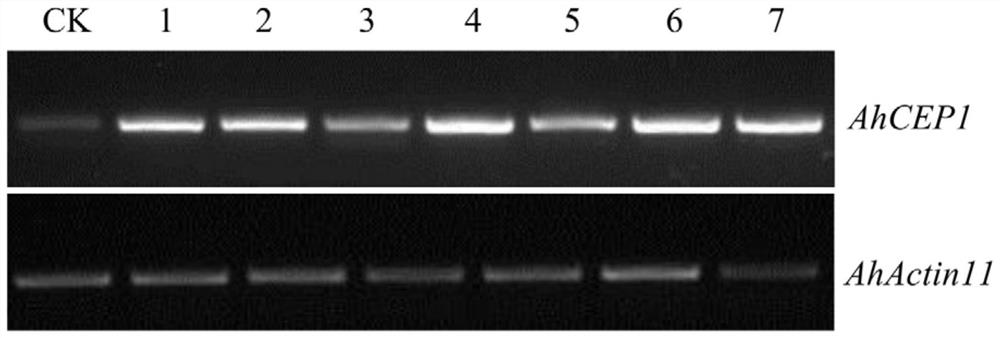Application of peanut hairy root lines in improving peanut tolerance to low nitrogen and high salt
A technology of hairy roots and peanuts, applied in the field of plant genetic engineering, to achieve the effect of avoiding long breeding cycle, short cycle and easy operation
- Summary
- Abstract
- Description
- Claims
- Application Information
AI Technical Summary
Problems solved by technology
Method used
Image
Examples
Embodiment 1
[0039] Example 1: Extraction and reverse transcription of peanut RNA
[0040] (1) Experimental materials:
[0041] · Culture medium:
[0042]Escherichia coli LB liquid medium, ingredients: tryptone (Tryptone) 10g, yeast extract (Yeasextract) 5g, sodium chloride (NaCl) 10g, distilled water 1000mL, adjust the pH to 7.0, sterilize by autoclaving at 121°C for 20min.
[0043] Agrobacterium rhizogenes YEP liquid medium, ingredients: tryptone (Tryptone) 10g, yeast extract (Yeasextract) 10g, sodium chloride (NaCl) 5g, distilled water 1000mL, adjust pH to 7.0, sterilize by high pressure steam at 121°C for 20min.
[0044] Hairy root induction and propagation MS medium, component: 25mL 20×MS large amount (3.8g KNO 3 , 3.3 g NH 4 NO 3 , 0.34g KH 2 PO 4 , distilled water 100mL), 5mL 100×MS trace (0.223g MnSO 4 4H 2 O, 0.086g ZnSO 4 ·7H 2 O, 0.062g H 3 BO 3 , 0.0083g KI, 2.5mg Na 2 MoO 4 2H 2 O, 0.25 mg CuSO 4 ·5H 2 O, 0.25 mg CoCl 2 ·6H 2 O, distilled water 100mL), 5mL 1...
Embodiment 2
[0064] Embodiment 2: Cloning and expression vector construction of AhCEP1 gene
[0065] (1) Experimental materials:
[0066] AhCEP1 gene primer sequence:
[0067] Upstream primer 5'- GGATCC ATGGCCAATTCCAAACTTGTGTTG-3';
[0068] Downstream primer 5'- GAGCTC CTAGTTTGGCGTGGGGGAGG-3';
[0069] Wherein the underline is the restriction site, the restriction site of the upstream primer is BamHI, and the restriction site of the downstream primer is SacI.
[0070] (2) Experimental method:
[0071] Cloning of Q1 and AhCEP1 genes
[0072] (Q1-1) Using peanut cDNA as a template, use Novizyme high-fidelity enzyme (2×Phanta Max Master Mix, p515) to amplify AhCEP1. The reaction system is: 2×Phanta Max Master Mix 12.5 μL, upstream primer 1 μL, downstream 1 μL of primers, 1 μL of cDNA template, and make up to 25 μL with water;
[0073] The PCR reaction system is: pre-denaturation at 95°C for 5 minutes, denaturation at 95°C for 25s, annealing at 55°C for 25s, extension at 72°C for 20s...
Embodiment 3
[0082] Example 3: Induction of Transgenic Peanut Hairy Roots
[0083] P1, acquisition of peanut explants
[0084] The peanut seeds of Luhua No. 11 were planted in flower pots (bottom diameter: 36 cm, flower pot height: 26 cm) in an artificial climate chamber. Peanuts were planted as a single seed, with 4 seeds per pot. 8h dark. Peanut seedlings grow to the stage of 3-6 compound leaves, and 2-4 compound leaves are selected from the bottom up as experimental materials. Rinse the peanut leaves with tap water for 10 minutes, wash them gently with sterile water for 2 minutes, soak them in 4% sodium hypochlorite solution for 2 minutes, and take the slightly white incision of the petiole as the standard. Then wash with sterile water for 3-4 times, soak in sterile water for 10 minutes, and dry the water for later use;
[0085] P2, AhCEP1-R1601 strain activation
[0086] Pipette 100 μL of AhCEP1-R1601 Agrobacterium stored at -80°C and inoculate it into 100 mL of YEP liquid medium c...
PUM
 Login to View More
Login to View More Abstract
Description
Claims
Application Information
 Login to View More
Login to View More - R&D Engineer
- R&D Manager
- IP Professional
- Industry Leading Data Capabilities
- Powerful AI technology
- Patent DNA Extraction
Browse by: Latest US Patents, China's latest patents, Technical Efficacy Thesaurus, Application Domain, Technology Topic, Popular Technical Reports.
© 2024 PatSnap. All rights reserved.Legal|Privacy policy|Modern Slavery Act Transparency Statement|Sitemap|About US| Contact US: help@patsnap.com










